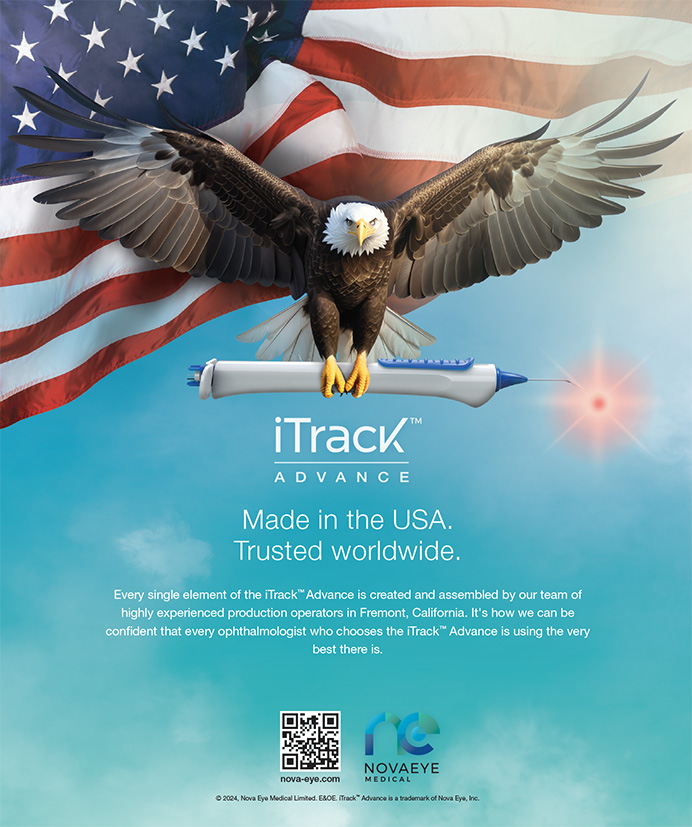Postoperative anterior segment inflammation can present with either an infectious or sterile etiology. By analyzing cultures, the timing of onset, and patients' responses to therapy, it is possible to differentiate between an infectious and sterile etiology, a distinction that is of the utmost importance because their treatments differ.
Sterile endophthalmitis, also known as toxic anterior segment syndrome (TASS), usually becomes manifest 12 to 24 hours postoperatively—sooner than infectious endophthalmitis and with different signs and symptoms. Patients often present with decreased visual acuity, corneal edema, a dilated nonreactive pupil, and a mild-to-severe anterior chamber reaction with cells, flare, hypopyon, and fibrin (Figure 1). TASS can result in marked corneal edema (characterized as limbus-to-limbus) (Figure 2) and even permanent, irreversible corneal decompensation.1 Any pain is mild to moderate, and the IOP may rise acutely.
CAUSES
Overview
There are multiple causes for TASS, and cases are often clustered. Trauma from the surgical procedure, denatured viscoelastic, irrigating solutions with an abnormal pH or ionic composition, residual sterilizing agents, or detergent remaining in reusable equipment can all cause inflammation. Residual lens cortex, endotoxins not destroyed by sterilization, and preservatives in ophthalmic solutions can also elicit an adverse reaction from a patient.2 Additionally, problems with the IOL design or finish, chemical composition, or sterilization can cause TASS.3,4 Often the inciting factor for TASS is unknown, but a few cases have been published linking cause and effect.
Residues and Medication
A group of patients developed a sterile inflammatory reaction to viscoelastic that remained in reusable cannulas and was denatured during the heat sterilization process.5 Other documented causes of TASS include aminoglycoside antibiotics that errantly penetrated through the surgical wound, as well as residual detergent and viscoelastic trapped inside irrigating cannulas.6
Bacterial Endotoxins
Another reported incidence of TASS was related to Klebsiella bacteria, which contaminated the ultrasound bath that was used to clean the surgical instruments.7 The bacteria were killed during the sterilization process, but a heat-stable endotoxin remained on the instruments and caused the outbreak.
BSS/Preservatives
Benzalkonium chloride, a cationic detergent commonly used as a preservative in topical ophthalmic solutions, has been found to damage corneal endothelial cells. A published report1 states that 12 of 19 patients developed corneal edema after exposure to BSS (Alcon Laboratories, Inc., Fort Worth, TX) preserved with benzalkonium chloride 0.001%. Other preservatives that can damage the corneal endothelium include sodium bisulfite 0.1% and thimerosal 0.01%.
Additionally, investigators have reported on nine of
68 patients who developed sterile endophthalmitis.8 The only common factor between the cases was the use of refrigerated BSS. The investigators postulated that the cold BSS did not allow the corneal tissue to swell enough to seal the incision, so toxic fluids injected subconjunctivally had the opportunity to seep into the wound and cause TASS.
IOL
In 2000, the MemoryLens IOL (CIBA Vision, Duluth, GA) was associated with an outbreak of TASS.4 Approximately 8 days after undergoing uneventful cataract surgery, 10 patients developed delayed-onset, acute, sterile endophthalmitis. All of them responded to steroids, and the inflammation resolved. An extensive evaluation of the potential sources for this inflammatory reaction revealed residual polishing compound on the IOLs as the likely source of this isolated outbreak of TASS. Since the initial report, there have been no further reported cases of delayed-onset postoperative inflammation associated with this lens.
PREVENTION
Instrumentation
Phacoemulsification handpieces and I/A handpieces are potential sources of toxicity. Although these handpieces are sterilized after each procedure, the autoclaving process can break down any residual viscoelastic or cortex, which can cause inflammation when injected into the eye during the next procedure for which the handpieces are used. Phacoemulsification and I/A handpieces should be thoroughly flushed after each use and only used for their recommended lifetime. Bear in mind that disposable tubing may have a lower potential for causing TASS than does reusable tubing, which must be sterilized.
Ensure that any cannulas soaked in a water or milk bath between cases are adequately rinsed prior to sterilization. Residual solution in the lumen of the cannula can be toxic when injected into the anterior chamber of the eye. Also, replace these milk or water baths frequently to ensure their sterility. When left unchanged for an extended period of time, they can grow gram-negative bacteria. Autoclaving will kill these bacteria but will leave behind a heat-stable endotoxin that can cause postoperative sterile endophthalmitis. Using only disposable cannulas with viscoelastic agents will eliminate problems associated with residual material inside or the sterilization of these instruments.
Medications
The most important method for preventing TASS is to minimize the possibility of intraocular contamination with potentially toxic substances. Carefully preparing for surgery can prevent many potential cases.
Medications used either in the BSS or injected into the eye during surgery deserve scrutiny. As a means of reducing the chance of complications, it is important to have stringent, yet easily reproducible, instructions on preparing BSS for either an in-house pharmacy or nursing staff. Review any medication that is going to be introduced into the BSS bottle for amount and concentration, as well as any antibiotics or epinephrine that might be used. Ensure that the epinephrine is preservative-free (including any bisulfite preservatives). It is also important to evaluate antibiotics that might be added to the irrigating solution, especially gentamicin, which has a relatively low therapeutic index and can be toxic at higher dilutions within the eye. Because the efficacy of using antibiotics in the irrigating solution is still unclear, this practice should be reviewed and possibly discontinued.9,10
Lastly, review all other medications used pre- and postoperatively in order to ensure that they are not a potential source of inflammation. This is especially important when using generic medications. Scrutinize their contents for different preservatives or other chemicals from their brand-name counterparts, because any dissimilar compounds could cause inflammation.
TREATMENT
The standard of treatment for sterile endophthalmitis has not been as thoroughly studied as that for infectious endophthalmitis. Much of the difference is attributable to the fact that TASS is often mistaken for, and initially treated as, an infectious inflammation. In the literature, several cases were diagnosed as TASS after cultures proved to be negative and patients' symptoms improved following the discontinuation of antibiotics.6
The treatments for TASS published in reports therefore vary. The most common treatment, however, is the use of corticosteroids to decrease inflammation.4,8 This approach involves an intense regimen of topical steroids (prednisolone acetate 1%) given hourly, with or without a course of oral steroids (prednisone). The IOP must also be carefully evaluated.
Surgeons should closely follow patients with postoperative inflammation for the first several days after the onset of symptoms, especially if an infectious etiology is possible. The patients with TASS will usually respond readily to topical steroid treatment, which may then be tapered accordingly. More severe cases of TASS, however, may result in permanent damage with corneal edema, glaucoma, and a fixed, dilated pupil.
CONCLUSION
Whether sterile or infectious, endophthalmitis is a serious, potentially devastating complication of cataract surgery. Further research is needed to evaluate its etiology and treatments. With careful evaluation of technique, medications, and handling of equipment, we can hope to decrease further the incidence of TASS.
This work is supported in part by a grant from Research to Prevent Blindness in New York to the Department of Ophthalmology and Visual Sciences, The University of Utah.
Brandon L. Davis, MD, is an ophthalmic pathology/research fellow. He holds no financial interest in any of the products mentioned herein. Dr. Davis may be reached at (801) 585-6506; brandon.davis@hsc.utah.edu.
Nick Mamalis, MD, is Professor of Ophthalmology at the John Moran Eye Center, University of Utah. He holds no financial interest in any of the products mentioned herein. Dr. Mamalis may be reached at (801) 581-6586; nick.mamalis@hsc.utah.edu.
1. Liu H, Routly I, Teichmann KD. Toxic endothelial cell destruction from intraocular benzalkonium chloride. J Cataract Refract Surg. 2001;27:1746-1750.
2. Davis BL, Kearsley L, Mamalis N. Postoperative endophthalmitis vs. toxic anterior segment syndrome. Ophthalmic Hyperguide. Available at: http://www.ophthalmic.hyperguides.com. Accessed December 5, 2002.
3. Mamalis N. Inflammation. In: Charlton JF, Weinstein GW, eds. Ophthalmic Surgery Complications. Philadelphia, PA: JB Lippincott Co; 1995:313-332.
4. Jehan FS, Mamalis N, Spencer TS, et al. Postoperative sterile endophthalmitis (TASS) associated with the MemoryLens. J Cataract Refract Surg. 2000;26:1773-1777.
5. Kim JH. Intraocular inflammation of denatured viscoelastic substance in cases of cataract extraction and lens implantation. J Cataract Refract Surg. 1987;13:537-542.
6. Monson MC, Mamalis N, Olson RJ. Toxic anterior segment inflammation following cataract surgery. J Cataract Refract Surg. 1992;18:184-189.
7. Kreisler KR, Martin SS, Young CW, et al. Postoperative inflammation following cataract extraction caused by bacterial contamination of the cleaning bath detergent. J Cataract Refract Surg. 1992;18:106-110.
8. Nelson DB, Donnenfeld ED, Perry HD. Sterile endophthalmitis after sutureless cataract surgery. Ophthalmology. 1992;99:1655-1657.
9. Ferro JF, de-Pablos M, Logrono MJ, et al. Postoperative contamination after using vancomycin and gentamicin during phacoemulsification. Arch Ophthalmol. 1997;115:165-170.
10. Gimbel HV, Sun R, DeBroff BM, Yang HM. Anterior chamber fluid cultures following phacoemulsification and posterior chamber lens implantation. Ophthalmic Surg Lasers. 1996;27:121-126.


